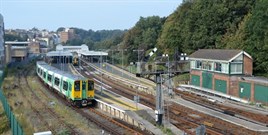“We were asked whether there was anything NR could do to double the route,” he tells RAIL. But the danger was that NR would be “spending millions to gain seconds”, so attention turned to the Marshlink line instead.
And with the eight-stage GRIP template required before any work can begin, Wood reiterates the need to “follow due process”.
Birch suggests to RAIL that it is fairly clear-cut that Marshlink would be electrified with the third rail system, but Wood believes that it is less defined at present.
“We need to electrify Marshlink with either OLE or third rail,” he says. That could involve merely laying a conductor rail from Ore onwards (where the Ore-Ashford non-electrified section begins) or alternatively extending overhead electrification from HS1 to Ore (after which point Javelins would ‘pan-down’ and use third rail). The latter option would potentially complicate matters at Ashford, where all of the other non-HS1 routes use the third rail system.
A longer ‘dynamic’ passing loop at Rye station would also enhance capacity, paving the way for a half-hourly frequency. The likely plan could entail HS1 trains terminating at Bexhill-on-Sea, which has an even longer journey time to London than Hastings. “We cannot forget Bexhill,” adds Wood.
He reiterates that the operation of high-speed EMUs running off HS1 onto classic routes has been successful. However, a larger fleet of Javelin units would undoubtedly be needed for any additional routes - the current fleet of 29 six-car trains operated by Southeastern is already well used.
“High-speed capacity is taken up with the Canterbury and Folkestone routes,” says Wood. He says any additional paths on HS1 - while not exactly a congested route at present - would need to be negotiated, with the potential for future additional international trains. There is also a full work bank in Control Period 5 (2014-19). “Our CP5 work is full with regards to resignalling,” he says.
Hope lies with the Kent Route Study, which kicks off in the spring and which will help inform choices over work that can be undertaken in CP6 (post-2019). Before then, an Electrification Route Utilisation Study, which may or may not be supportive, is due to be published early in 2015.
Wood suggests that Marshlink would need to be among the top ten priorities in order to have a fighting chance of achieving the full HS1 connectivity. While the Department for Transport and Office of Rail Regulation is predisposed towards overhead electrification for any ‘new’ schemes, Wood suggests that in scenarios where NR can prove the case for an ‘infill’ electrification on the third rail network, then that is not out of the question.
Only when those studies are released will it be known how much high-level support there is internally among NR’s planners. Meanwhile, in parallel with local authority work to build a regeneration benefits case, NR is undertaking pre-GRIP work to understand the benefits of the scheme. “From the work we’ve done, we believe we can get a 100-minute Hastings-London journey time down to 68 minutes,” confirms Wood.
But there are severe resource constraints in CP5, and decisions to be made about the train service of the future. Who will fund extra HS1-compatible trains? What will happen to the residual Marshlink service calling at smaller stations such as Appledore and Winchelsea? The Thameslink-Southern-Great Northern franchise (currently operated by Govia Thameslink Railway) is due for renewal in around 2020, which may provide an opportunity to integrate a new Hastings route as well as other remapping of the neighbouring Integrated Kent franchise operated by Southeastern.
Wood is optimistic for Marshlink regardless, suggesting that whether electrification options are fully developed or not, the Kent RUS will “look at the case for Marshlink line speed increases”. Ultimately, however, he adds: “It is up to the DfT to decide what they want to fund. This scheme is in competition with many others.”
Political ambition does not necessarily chime with the ability of NR to undertake the work, let alone fund it from the £38 billion allocated for 2014-2019 (CP5), or indeed CP6.
Yet Hastings MP Amber Rudd is adamant, according to her own website, that such “absolute commitments” are already in place. Referring to McLoughlin’s “absolute commitment”, she appears to suggest that the “new line - being built in 2019 - will mean we can get from Hastings to London in 66 minutes”. So, is that realistic?
“I have wanted to step it up and make it more ambitious,” says Rudd, speaking directly to RAIL on a dark midwinter afternoon.
NR has told Rudd that the main hurdle to overcome with bringing the project forward is signalling expertise. But that’s before a realistic price tag or business case has been adopted for the scheme, as well as the various GRIP stages that any railway infrastructure investment must go through.
Even so, Rudd is optimistic that such challenges can be overcome, with the support of the various councils (East Sussex, Rother and Hastings) working together. RAIL suggests to Rudd that it’s not just about political support or a lack of clear funding, but also a lack of expertise available - the relevant engineers are apparently all busy on other projects.














Login to comment
Comments
No comments have been made yet.